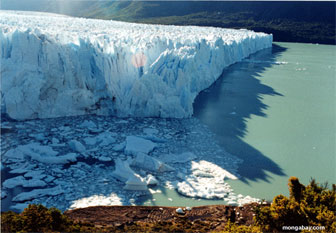Long-term cooling driven by Antarctica, not glaciers in Northern Hemisphere
Brown research argues Pacific temperature change caused by icy current
Rhett A. Butler, mongabay.com
April 10, 2006
Researchers from Brown University have reconstructed 5-million years of climate using tiny marine fossils found in mud off the coast of South America. The climate record unearthed by the Brown team is the longest continuous record of ocean temperatures on Earth.
The scientists found evidence that suggests cold ocean regions near Antarctica were the main driver of cooling in the eastern equatorial Pacific (EEP) over the past 3 million years–not glacier growth in the high northern latitudes, as previous theories argued.
“The Southern Hemisphere, not the Northern Hemisphere, more likely had a stronger effect on temperature and productivity in the eastern Pacific,” said Kira Lawrence, lead author of the paper which appeared in the journal Science. “We may need to refocus where we look to understand the evolution of climate over the past 5 million years.”
Lawrence and the team of geologists from Brown found that surface temperatures in the eastern equatorial Pacific were 27° Celsius 5 million years ago and have steadily declined by roughly one degree Celsius every million years since. Currently surface temperatures stand at 23 Celsius, but research elsewhere indicates that global sea temperatures are increasing. The Brown study suggests that higher ocean temperatures could have a significant impact in the future.

|
“Results from the past prove that it is possible for the EEP to exist in a kind of permanent El Niño state, which would have immense climate and biological repercussions if it were to happen again under global warming,” Herbert said. “The geological evidence also suggests that to predict warming in the EEP, the key ocean region to monitor is near Antarctica.”
El Niño is a large-scale warming in the eastern equatorial Pacific that “slows the upwelling of cold water and forces changes in weather, such as droughts or floods, far from the tropical Pacific” say the researchers in a statement. In recent years, El Niño has triggered unusual weather patterns around the world, including drought in southeast Asia and terrific storms along the west coast of the United States.
This article used media materials provided by Brown University.